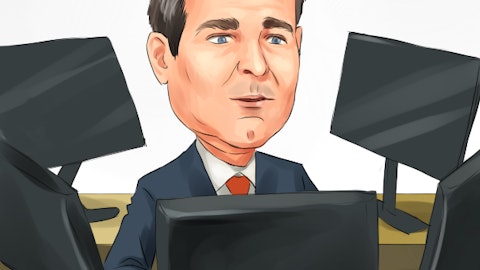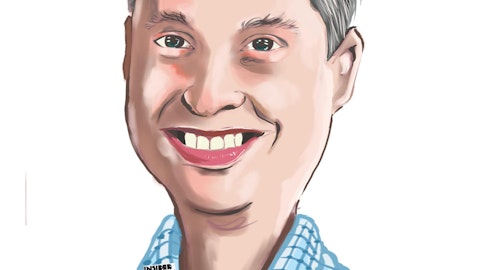BankFinancial Corporation (NASDAQ:BFIN) Q4 2023 Earnings Call Transcript February 6, 2024
BankFinancial Corporation isn’t one of the 30 most popular stocks among hedge funds at the end of the third quarter (see the details here).
Operator: Good day, and thank you for standing by. Welcome to the BankFinancial Corp. 2024 Year End Earnings Conference Call. At this time, all participants are in a listen-only mode. After the speaker’s presentation, there will be a question-and-answer session. [Operator Instructions] Please be advised that today’s conference is being recorded. I would now like to hand the conference over to your first speaker today Chairman and CEO Mr. Morgan Gasior. Please go ahead.
Morgan Gasior: Good morning. Welcome to the Fourth Quarter 2023 Investor Conference Call. At this time, I’d like to have our forward-looking statement read.

Katie Multon: The remarks made at this conference may include forward-looking statements within the meaning of Section 21-E of the Securities Exchange Act of 1934. We intend all forward-looking statements to be covered by the Safe Harbor provisions contained in the Private Securities Litigation Reform Act of 1995, and are included in this statement for purposes of invoking these safe harbor provisions. Forward-looking statements involve significant risks and uncertainties and are based on assumptions that may or may not occur. They are often identifiable by use of the words beliefs, expects, intend, anticipate, estimate, project, plan or similar expressions. Our ability to predict results or the actual effect of our plans and strategies is inherently uncertain and actual results may differ from those predicted.
For further details on the risks and uncertainties that could impact our financial condition and results of operation, please consult the forward-looking statements declaration and the risk factors we have included in our reports to the SEC. These risks and uncertainties should be considered in evaluating forward-looking statements. We do not undertake any obligation to update any forward-looking statements in the future. And now, I’ll turn the call over to Chairman and CEO Mr. F. Morgan Gasior.
Morgan Gasior: Thank you. At this time we filed our press release and our 5-quarter supplement. The Form 10-K will be filed on its normal schedule in compliance with SEC requirements. So at this time all of our filings are complete today. We’ll open it up for questions.
See also 12 Best Asian Dating Sites Without Payment and 15 Best Gay Dating Sites and Apps of 2024.
Q&A Session
Follow Bankfinancial Corp (NASDAQ:BFIN)
Follow Bankfinancial Corp (NASDAQ:BFIN)
Operator: Thank you. [Operator Instructions] And our first question will come from the line of Brian Martin from Janney.
Brian Martin: Hey, good morning.
Morgan Gasior: Good morning and happy New Year, Brian.
Brian Martin: Yeah. Happy New Year to your guys. I wanted Morgan to see, if you could see if you could give a little bit of color on just the loans in the quarter. Just it looks like there’s some nice growth in the commercial finance and some shrinkage in the Equipment Finance. I’m just wondering, if you can give a little bit of color on that and then just kind of your outlook here as you kind of go into 2024.
Morgan Gasior: Sure. Well, let’s start with commercial finance. It is — the priority has been and will continue to be the priority for resource allocation and growth. And we did have — we had good utilization in the quarter. It was a little lumpy, but the balance has stayed broadly steady. What we didn’t see as much are draws. We had lower overall volumes. So when you look at the originations for the quarter they were down. So we had good balances as a percentage of total commitments, but we just didn’t have as much draw activity in the fourth quarter. So that cost us a little bit, in what we’ll call intra-quarter interest income, right? Sometimes they’ll draw for a month or five weeks and then pay it off. And we saw quite a bit of that activity in third quarter.
It was very helpful hence the focus on commercial finance and a little bit less so in the fourth quarter. So the balances were steady during the quarter. We just didn’t see the draw and payoff activity that generates that marginal interest income during the quarter. We’re going into 2024 with some reasonably good pipelines in the health care space. We’re adding some new lessors, in lessor finance in the Equipment Finance space. And we have some of the Chicago commercial finance pipeline starting to build. Probably the biggest focus compared to 2023, is that, as we said before, we’re repositioning resources into commercial finance from a personnel perspective. This will be essentially, budget neutral. We’re putting more resources into commercial finance and less, resources into real estate, given the relative spread and the opportunities.
So to that extent, we’ll probably have, triple the resources devoted to commercial finance in 2024, than we did in the beginning of 2023. We’ve gone through an essentially graduate school of credit training, for these personnel. Some customers — some of them come to us with good C&I experience, in their past or their most recent past. But everybody’s had different credit training and different credit experience. So in the fourth quarter, we put all of our credit personnel, including the credit analysts through a graduate style course, so that everybody is up to the same speed as far as credit skills. Now they’re going through the product training, given our base of products where we can offer a customer, a standard bank credit loan, an ABL platform or accounts receivable factoring or some combination thereof.
That is a unique product set in the market. And we need to make sure they fully understand the product. And how it works to go out and sell it. And then Commercial Finance is going to take the lion’s share, within the commercial space of marketing expense. So that is going to be our focus for 2024. The difficulty of course is utilization. As much as we grow commitments, we have any number of commercial customers that aren’t using their lines very much. An example, just this week, we have a customer that has a $7 million commitment. Their balance at 12/31 and into January was $700,000, but they recently filed an increase to go to $15 million, because they see some significant seasonal activity coming up. Once that seasonal activity is complete, probably by the end of third quarter they want the commitment to go back down to save them the non-use fee.
We can work with them on that. But it just gives you a sense of sometimes, how volatile the line utilization can be. You can build a lot of commitments. You don’t always see the utilization right away. And then suddenly something changes. So, some of our borrowers are pretty steady borrowers. It’s the nature of their business. Healthcare can be like that. In other cases, it’s very seasonal and spotty. And we just have to kind of roll with it. But growing the base of customers and growing the commitment base, all the way from the small business side, business banking down to $100,000 $250,000 lines because we want that Core Checking account on up to the larger corporate exposures that’s the focus for 2024. As far as Equipment Finance is concerned, you saw the benefits from an asset-liability perspective, management perspective.
You saw the benefits from Equipment Finance. We had approximately $200 million of scheduled payments that we received in 2023 and we were able to reposition that into liquid funds and into originations at much higher rates. So that was a significant benefit to us. And in the fourth quarter, typically that is our strongest originations quarter. Just it’s historically always been that way which means of course that, if you originate it in third and fourth quarter you will get the payments, a greater proportion of payments in third and fourth quarter and that’s what’s happened to us. For 2024, we’re going to see approximately $130 million of cash flows coming off the portfolio; the portfolio is smaller. So our goal is to reposition the $130 million into primarily the corporate side, investment grade and rated corporate and then, a little bit of middle market and small ticket.
And then, at that point we’ll produce as much as a 200 to 250 point increase in yields just from those cash flows alone. And then real estate Real Estate had a quiet year. Rates spiked. We were in the 7’s percent for a bit of time. That obviously dampened activity on a number of levels. But here in just the last few weeks, because the treasury curve has come down some, we’re starting to see some refinance opportunities come out. We’ve seen a couple of customers that want to do equity cash-outs because they want to buy a value-add building. Their credit profile with us is strong so we’re able to work with them. And what that does is give us a higher-yielding note on the original exposure and of course the higher-yielding assets on the new exposure.
So, I still think real estate will be the smallest of the originations in 2024 just because of where the market is right now. But we are starting to see better interest in originations than we did say in second and third quarter and even early fourth because the yield curve has shifted.
Brian Martin: Got you. Okay. And you said the pipelines are pretty strong right now heading into the part of 2024?
Morgan Gasior: I would say they’re variable. The commercial finance we’re seeing growth in the commercial finance pipeline and the health care pipeline. We have some good opportunities that we’re working through in the lessor finance. How often they draw is an open question, but we’re seeing commitment opportunities. Equipment Finance is starting to grow, but it’s still kind of thin I would say. We’re just getting ready — we just revised pricing here in January. And as I said we’re going through the credit training, but we just revised pricing based on where the curve is. Let me also say that especially in the higher quality investment grade and high-quality corporate spreads are very tight. We’re able to invest in short-term CDs right now in the mid to high 5s.
And the yields on investment-grade corporates are in the mid to high 5s. So, it’s very, very tight spreads. Obviously, people are concerned that there could be a recession may be less concerned after 3.3% GDP growth in the fourth quarter but still concerned. But the spreads are wider out in the middle market in the small-ticket space. Obviously, those are somewhat weaker companies potentially higher credit risk and so the spreads are a little wider out there. But we’re just getting started with the outreach on the corporate side and the investment-grade side. We’ve got our cash flows marked for that. And we’re going to push as hard as we can to put some volume up sooner in the year to help protect the interest income of the position. And if the treasury yield curve were to decline further, if the Fed really starts moving later in the year, this way we’ll lock in some yields now and get the benefit of the income earlier in the year and protect interest income going forward.
Brian Martin: Got you. Okay. And just maybe two others for me Morgan. Just if you give a little bit of thought or if Paul just on the margin outlook here with the rate cuts but knowing the redeployment that you’re thinking about here, just how you’re thinking about either the dollars of net interest income. Kind of are we seeing a trajectory where it’s kind of up throughout the year given the growth, or are we — just in terms of margin perspective? And then maybe just a little bit of thought on — an update on kind of credit quality [indiscernible]
Morgan Gasior: Well, let me do both of those and then Paul can fill it in on net interest margin. In the fourth quarter, we had a decline in interest income of about $200,000, principally due to just a decline in interest-earning assets. That was an impact. And then the second component in the fourth quarter was the lower origination activity, line activity, intra-period line activity. That kind of flattened out our growth in interest income compared to third quarter. And then, of course, we continue to see some increases in interest — deposit interest expense in the fourth quarter. So, going forward we see the net interest margin as a percentage staying relatively stable in the first six months. And then we hope because the impact of originations as we go through the year is cumulative also because we’ll have securities that are maturing and repositioning in either securities or CDs or loans the securities portfolio the average yield on the securities portfolio that’s maturing this year is 3%.
So, we feel pretty comfortable about picking up at least a couple hundred points on that during the course of the year. Same for the maturing payments on Equipment Finance as we put that cash to work those yields are in the mid to high 4s. We should still be able to pick up at least 100 points to 150 points on those cash flows. So, I’d say stable. We hope to keep things stable in the first half assuming that the balance sheet is stable no degradation of interest-earning assets and then start to expand the percentage and increase the dollar amount of net interest margin in the second two quarters as we can put the cash flows to work.
Brian Martin: Perfect. Thanks.



